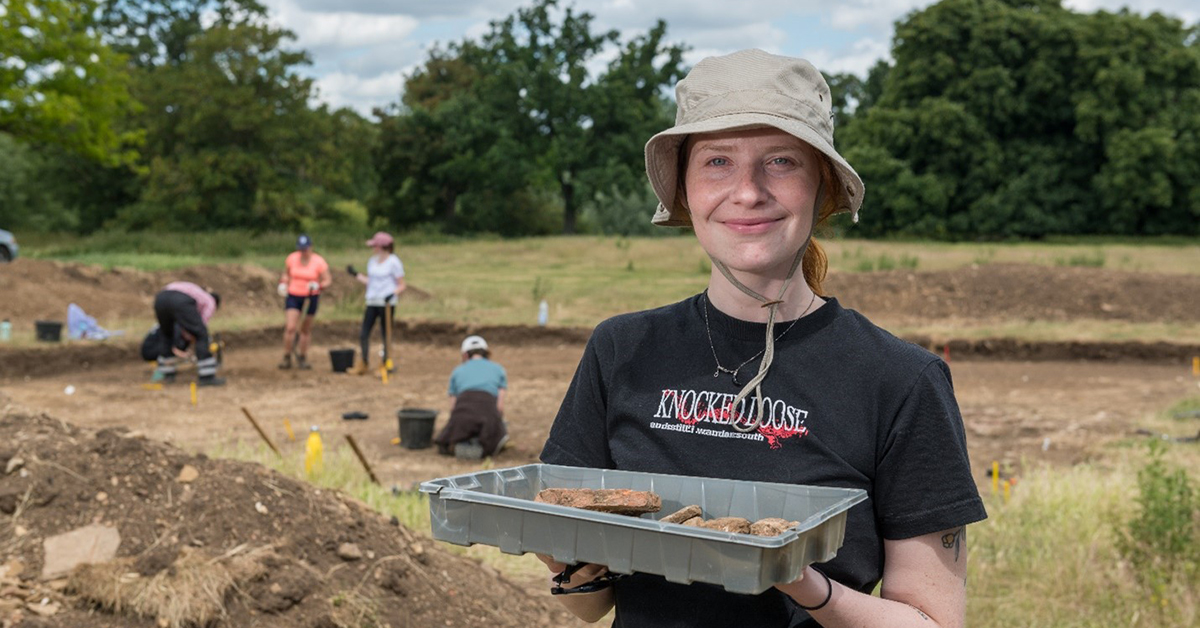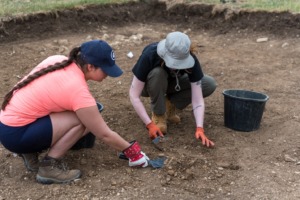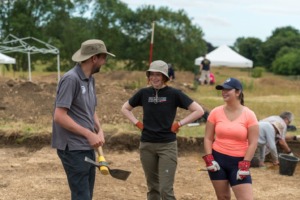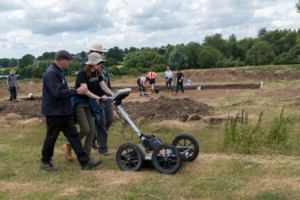My first time on a camping archaeological dig
03/10/2022

Hannah Kloster, current Forensic Archaeology and Anthropology MSc student, talks about her experiences on a recent archaeological dig with Cranfield Forensic Institute (CFI).
Was it your first time on such a dig?
This was my first time doing a week-long camping archaeological dig! I was excited to finally have some real experience in this setting, along with some of the close friends I had made throughout my journey at Cranfield. I was hesitant about the camping aspect, but over the week, you settle in and get to know your surroundings and the people you are with even more.
How did you prepare?
I knew that we were going to be camping, so several trips to the shops were made to stock up on non-perishables and those giant 5-litre jugs of water! My friends and I ended up pooling many resources and sharing things like camp stoves, tents, chairs, and other camping essentials.
Regarding clothes, it was necessary to pack for all weather due to England’s ever-changing climate! It was undoubtedly hot in the sun during the day but surprisingly cold in the evenings. So, layering was crucial. Also, a good pair of either hiking boots or safety boots were needed for a dig (plus waterproof clothing!). And we couldn’t forget sunscreen, sunglasses, and a good bucket hat!

Be prepared and have the right equipment: boots and a hat are crucial.
What were the challenges?
I think the biggest challenge, in the beginning, was trying to determine what it was that we were seeing. There were two trenches. The first trench had already been worked on from a previous year, and features were a lot more visible, but the second was just emerging. As someone with little to no experience with Roman architecture, it was difficult for me to decipher important artifacts/features/building material from, let’s say, just your everyday stones or rubble. However, we were able to work and learn from experienced lead archaeologists on site who helped us through this learning process. From the start of the week to the end, I was confident enough to identify features that I wouldn’t have previously.
Physical fitness is also a challenge because this requires you to be on your feet and move your body for long hours. I can confidently say I discovered muscles I never had before.

Learning from experienced archaeologists.
What did you learn?
I came to Cranfield with the idea of only wanting to pursue a future in forensics, but after doing this module and learning about these types of archaeological digs, I would love to do more. I learned that no matter what your experience is or where you are, if you enjoy what you are doing and who you are doing it with, you can get far.
I gained essential knowledge of the theoretical excavation techniques required for archaeology and how to record material that is discovered which will help me in my future. I also learned that digging up the past really helps us understand more about the individuals who lived during this time, their culture, history, and their lives. Being able to unearth critical pieces that show evidence of the past is something that excites me, and I know I want to keep doing it.
How did it tie in with your courses at Cranfield?
This module was certainly different since it focused on a conventional archaeological excavation, but I think it is highly important for anyone interested in this field. The skills and knowledge we learned from our previous courses were applied to this dig, such as understanding the various soil properties and compositions, stratigraphy and Harris Matrix, context recording, and surveying (plus many more).
This module gave me an insight into another side of archaeology, and I am so happy I could be a part of it. I am now doing my thesis project on analysing the Roman-painted plaster that was excavated from the site…
…so stay tuned!

Using ground-penetrating radar to see what is below the surface.
What did you enjoy the most?
Being able to do ground-penetrating radar was one of my highlights of the week. It has always been something I was interested in learning more about, and thanks to Peter Masters, I could confidently use the GPR and really understand what I was looking at.
My experience was also what I enjoyed most. I want to thank Dave Errickson for helping all of us expand on our archaeological knowledge and practical skills throughout the week. He is incredible to learn from and knows exactly what to look for. He always makes it a point to show us the finds and keeps us updated as the dig is going on. For a module that welcomes individuals with all kinds of experience and all backgrounds, I couldn’t think of anyone better to learn from than Dave. I hope to come back next year as a volunteer, so I can continue seeing this site’s progress!
Categories & Tags:
Leave a comment on this post:
You might also like…
Keren Tuv: My Cranfield experience studying Renewable Energy
Hello, my name is Keren, I am from London, UK, and I am studying Renewable Energy MSc. My journey to discovering Cranfield University began when I first decided to return to academia to pursue ...
3D Metal Manufacturing in space: A look into the future
David Rico Sierra, Research Fellow in Additive Manufacturing, was recently involved in an exciting project to manufacture parts using 3D printers in space. Here he reflects on his time working with Airbus in Toulouse… ...
A Legacy of Courage: From India to Britain, Three Generations Find Their Home
My story begins with my grandfather, who plucked up the courage to travel aboard at the age of 22 and start a new life in the UK. I don’t think he would have thought that ...
Cranfield to JLR: mastering mechatronics for a dream career
My name is Jerin Tom, and in 2023 I graduated from Cranfield with an MSc in Automotive Mechatronics. Originally from India, I've always been fascinated by the world of automobiles. Why Cranfield and the ...
Bringing the vision of advanced air mobility closer to reality
Experts at Cranfield University led by Professor Antonios Tsourdos, Head of the Autonomous and Cyber-Physical Systems Centre, are part of the Air Mobility Ecosystem Consortium (AMEC), which aims to demonstrate the commercial and operational ...
Using grey literature in your research: A short guide
As you research and write your thesis, you might come across, or be looking for, ‘grey literature’. This is quite simply material that is either unpublished, or published but not in a commercial form. Types ...






